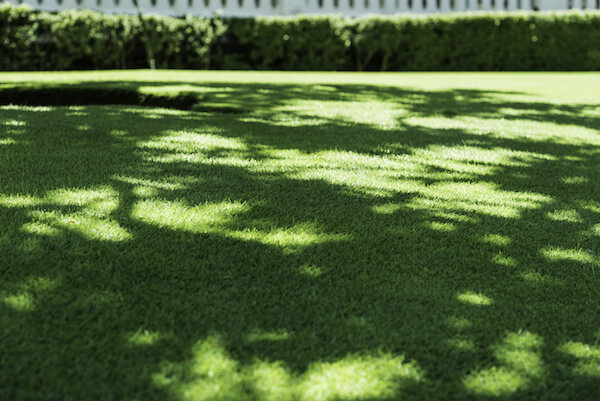
Turf in the Shade
For lawns to thrive, areas that don’t get at least six hours of direct sun a day require that you carefully select the sod variety that will be installed or restored on your property. A number of factors may affect how much sunlight reaches your grass. Buildings and trees can block sunlight, and sunlight varies by season too.
Evaluation of Sunlight
If you don’t know how much sunlight reaches your grass, a beneficial project is for you to record the amount of full sun, partial sun or full shade that reaches your sod. Make your assessments several times during the day. Also note whether tall trees allow some sun to come through and whether shorter trees block all the sun.Trimming back trees that block sunlight may be necessary in some instances.
Tips for Healthy Grass in Shade
Why is determining how much shade or sun a lawn or sports field gets so important? Lawns that are deficient in sunlight are riddled with long and thin leaves, which inhibit the vegetation’s intake of carbohydrates. This deficiency weakens grasses. One solution toward health is to mulch.
Another way to get healthier grass to grow in shady areas is to mow at the highest height professional sod installers recommend. By doing so, the leaf area increases. This allows grasses to absorb more light and grow deeper roots. Lawns in shady areas require less fertilizer because they grow more slowly. The general recommendation is to use a slow-release nitrogen fertilizer.
Other practices that promote healthy grass growth in shade is to water less frequently and avoid heavy traffic. Weed control is also important to producing beautiful turf in places that do not get much sunlight. Since these areas are covered by less grass, weeds are a common problem, and you may consider using preventive measures.
All climates are not the same and neither are all warm-season grasses used by our professional sod installers in Florida. Some varieties of grass tolerate reduced sun better than others. Here are seven varieties to consider.
Icon Zoysia
This variety performs excellently in shade. In areas where there is low foot traffic, it can handle up to 50% shade. Where wear traffic is moderate, it can tolerate up to 30% shade. Installers can lay it in sand, peat, clay or muck. This sod handles heat and cold well and tolerates drought and salt too. It’s not highly susceptible to weeds. Mow it to a height of 1” – 2.”
Palmetto St. Augustine
A St. Augustine cultivar, this grass has a softer texture than some other varieties of St. Augustine sod. It’s planted in clay, sand or muck. Developed to promote shade tolerance, it performs excellently in areas that get no more than four hours of direct sunlight daily. It also thrives in sunlight and has good wear tolerance. It’s very good under drought condition and exhibits average performance against diseases. Mow it to a height of 1.5 “- 2.5. “
Seville St. Augustine
A dwarf variety of St. Augustine grass, it performs well in full sun or shade. It can tolerate areas where there is as little as two hours of direct sun per day. Mow to a height of 2” – 2.5.”Weeds will not overtake this slow-growing grass.
Captiva St. Augustine
Its performance in shade is good to excellent. Developed to resist chinch bugs. this variety requires fewer applications of chemicals. Mow to a height of 2” – 3.” Its wear tolerance is very good. Another St. Augustine variety that has good shade tolerance is Sapphire St. Augustine.
Celebration Bermudagrass
This Bermudagrass tops most other Bermuda grasses in shade tolerance. It’s installed at homes, on sports fields and on golf courses. This cultivated grass has excellent drought and wear tolerance. Mow it to a height of 0.5” – 1.”
We’ve been growing sod since the early 1970’s, and we’re connected to a community of expert installers. They’ll help you as a homeowner, business owner, developer or manager of a sports field to choose the right variety of grass based on the amount of maintenance it will require, the conditions on your property and the look you want. Contact us today.